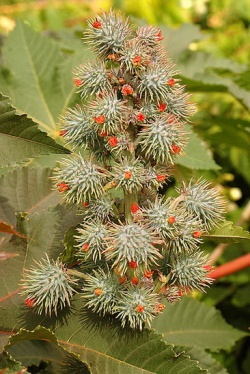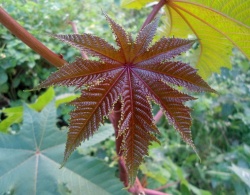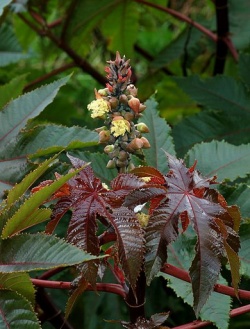Eranda
eranda
伊蘭 (Skt, Pali; Jpn iran )
A plant depicted in Buddhist scriptures as emitting a very foul odor, often mentioned in contrast with the fragrant sandalwood tree. The eranda is thought to refer to the castor-oil plant or a close relative, though the castor-oil plant does not emit a foul odor. According to the Ocean of Meditation on the Buddha Sutra, the odor of the eranda plant is similar to that of a rotting corpse and reaches a distance of forty yojanas. The sutra says that the fragrant sandalwood tree dispels the stench of the eranda. The eranda and its stench are cited as a metaphor for delusion and suffering, and the sandalwood and its wonderful fragrance as a metaphor for enlightenment or the purifying and beneficial power of the Buddhist Law.
The castor oil plant, Ricinus communis, is a species of flowering plant in the spurge family, Euphorbiaceae. It belongs to a monotypic genus, Ricinus, and subtribe, Ricininae. The evolution of castor and its relation to other species are currently being studied using modern genetic tools.
Its seed is the castor bean, which, despite its name, is not a true bean. Castor is indigenous to the southeastern Mediterranean Basin, Eastern Africa, and India, but is widespread throughout tropical regions (and widely grown elsewhere as an ornamental plant).
Castor seed is the source of castor oil, which has a wide variety of uses. The seeds contain between 40% and 60% oil that is rich in triglycerides, mainly ricinolein. The seed contains ricin, a toxin, which is also present in lower concentrations throughout the plant.
An unrelated plant species, Fatsia japonica, is similar in appearance and known as the false castor oil plant.
Description
The castor oil plant can vary greatly in its growth habit and appearance. The variability has been increased by breeders who have selected a range of cultivars for leaf and flower colours, and for oil production. It is a fast-growing, suckering perennial shrub that can reach the size of a small tree (around 12 metres or 39 feet), but it is not cold hardy.
The glossy leaves are 15–45 centimetres (5.9–18 in) long, long-stalked, alternate and palmate with 5–12 deep lobes with coarsely toothed segments. In some varieties they start off dark reddish purple or bronze when young, gradually changing to a dark green, sometimes with a reddish tinge, as they mature. The leaves of some other varieties are green practically from the start, whereas in yet others a pigment masks the green colour of all the chlorophyll-bearing parts, leaves, stems and young fruit, so that they remain a dramatic purple-to-reddish-brown throughout the life of the plant. Plants with the dark leaves can be found growing next to those with green leaves, so there probably is only a single gene controlling the production of the pigment in some varieties at least. The stems (and the spherical, spiny seed capsules) also vary in pigmentation. The fruit capsules of some varieties are more showy than the flowers.
The green capsule dries and splits into three sections, forcibly ejecting seeds
The flowers are borne in terminal panicle-like inflorescences of green or, in some varieties, shades of red monoecious flowers without petals. The male flowers are yellowish-green with prominent creamy stamens and are carried in ovoid spikes up to 15 centimetres (5.9 in) long; the female flowers, born at the tips of the spikes, have prominent red stigmas.
The fruit is a spiny, greenish (to reddish-purple) capsule containing large, oval, shiny, bean-like, highly poisonous seeds with variable brownish mottling. Castor seeds have a warty appendage called the caruncle, which is a type of elaiosome. The caruncle promotes the dispersal of the seed by ants (myrmecochory).
Nomenclature
The name Ricinus is a Latin word for tick; the seed is so named because it has markings and a bump at the end that resemble certain ticks. The common name "castor oil" probably comes from its use as a replacement for castoreum, a perfume base made from the dried perineal glands of the beaver (castor in Latin). It has another common name, palm of Christ, or Palma Christi, that derives from castor oil's reputed ability to heal wounds and cure ailments.
Medicinal uses
Castor oil has many uses in medicine and other applications.
An alcoholic extract of the leaf was shown, in lab rats, to protect the liver from damage from certain poisons. Methanolic extracts of the leaves of Ricinus communis were used in antimicrobial testing against eight pathogenic bacteria in rats and showed antimicrobial properties. The extract was not toxic. The pericarp of castor bean showed central nervous system effects in mice at low doses. At lower doses, the extract improved memory consolidation. At high doses mice quickly died. A water extract of the root bark showed analgesic activity in rats. Antihistamine and anti-inflammatory properties were found in ethanolic extract of Ricinus communis root bark.
Other uses
Extract of Ricinus communis exhibited acaricidal and insecticidal activities against the adult of Haemaphysalis bispinosa Neumann (Acarina: Ixodidae) and hematophagous fly Hippobosca maculata Leach (Diptera: Hippoboscidae).
The Bodo tribals of Bodoland, Assam (India), use the leaves of this plant to feed and rear the larvae of muga and endi silkworms.
Castor oil is a good motor lubricant and has been used in internal combustion engines, including those of World War I airplanes, some racing cars and some model airplanes. It does not mix with petroleum products. It has been largely replaced by synthetic oils that are more stable and less toxic.
Historical usage
Castor seeds have been found in Egyptian tombs dating back to 4000 BC; the slow burning oil was used mostly to fuel lamps. Herodotus and other Greek travellers noted the use of castor seed oil for lighting, body ointments, and improving hair growth and texture. Cleopatra is reputed to have used it to brighten the whites of her eyes. The Ebers Papyrus is an ancient Egyptian medical treatise believed to date from 1552 BC. Translated in 1872, it describes castor oil as a laxative.
The use of castor bean oil ("eranda") in India has been documented since 2000 BC in lamps and in local medicine as a laxative, purgative, and cathartic in Unani, Ayurvedic and other ethnomedical systems. Traditional Ayurvedic medicine considers castor oil the king of medicinals for curing arthritic diseases. It is regularly given to children orally, for de-worming.
Castor seed and its oil have also been used in China for centuries, mainly prescribed in local medicine for internal use or use in dressings.
Castor oil was used as an instrument of coercion by the paramilitary Blackshirts under the regime of Italian dictator Benito Mussolini. Dissidents and regime opponents were forced to ingest the oil in large amounts, triggering severe diarrhoea and dehydration, which could ultimately cause death. This punishment method was originally thought of by Gabriele D'Annunzio, the Italian poet and Fascist supporter, during the First World War
See also sandalwood tree.


